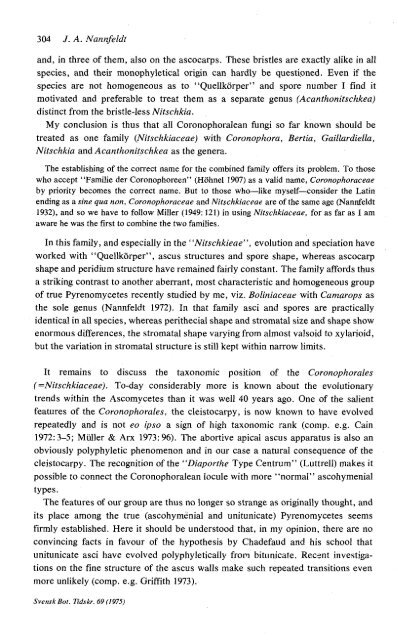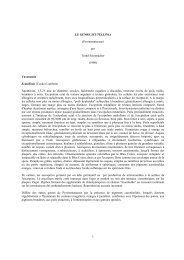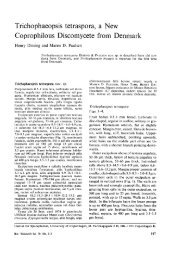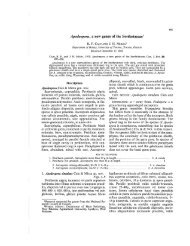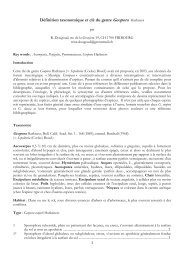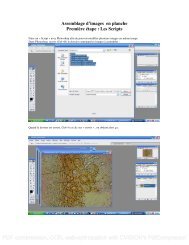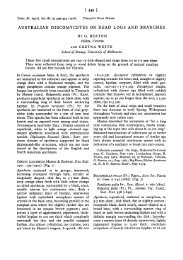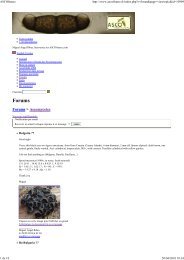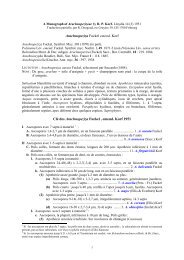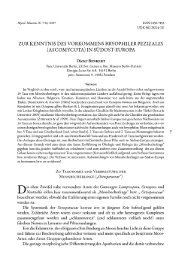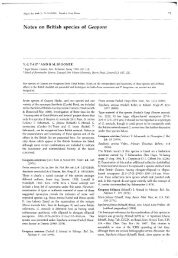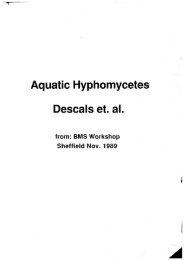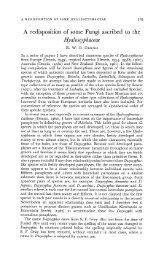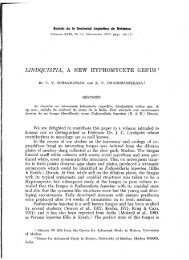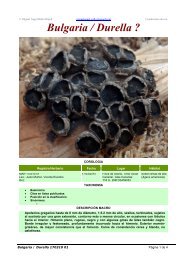Stray Studies in the Coronophorales (Pyrenomycetes) 4-8 - ASCOfrance
Stray Studies in the Coronophorales (Pyrenomycetes) 4-8 - ASCOfrance
Stray Studies in the Coronophorales (Pyrenomycetes) 4-8 - ASCOfrance
You also want an ePaper? Increase the reach of your titles
YUMPU automatically turns print PDFs into web optimized ePapers that Google loves.
304 J. A. Nannfeldtand, <strong>in</strong> three of <strong>the</strong>m, also on <strong>the</strong> ascocarps. These bristles are exactly alike <strong>in</strong> allspecies, and <strong>the</strong>ir monophyletical orig<strong>in</strong> can hardly be questioned. Even if <strong>the</strong>species are not homogeneous as to "Quellkorper" and spore number I f<strong>in</strong>d itmotivated and preferable to treat <strong>the</strong>m as a separate genusdist<strong>in</strong>ct from <strong>the</strong> bristle-lessNitschkia.(Acanthonitschkea)My conclusion is thus that all Coronophoralean fungi so far known should betreated as one family (Nitschkiaceae) with Coronophora, Bertia, Gaillardiella,Nitschkia and Acanthonitschkea as <strong>the</strong> genera.The establish<strong>in</strong>g of <strong>the</strong> correct name for <strong>the</strong> comb<strong>in</strong>ed family offers its problem. To thosewho accept "Familie der Coronophoreen" (Hohnel 1907) as a valid name, Coronophoraceaeby priority becomes <strong>the</strong> correct name. But to those who—like myself—consider <strong>the</strong> Lat<strong>in</strong>end<strong>in</strong>g as a s<strong>in</strong>e qua non, Coronophoraceae and Nitschkiaceae are of <strong>the</strong> same age (Nannfeldt1932), and so we have to follow Miller (1949:121) <strong>in</strong> us<strong>in</strong>g Nitschkiaceae, for as far as I amaware he was <strong>the</strong> first to comb<strong>in</strong>e <strong>the</strong> two families.In this family, and especially <strong>in</strong> <strong>the</strong> "Nitschkieae",evolution and speciation haveworked with "Quellkorper", ascus structures and spore shape, whereas ascocarpshape and peridium structure have rema<strong>in</strong>ed fairly constant. The family affords thusa strik<strong>in</strong>g contrast to ano<strong>the</strong>r aberrant, most characteristic and homogeneous groupof true <strong>Pyrenomycetes</strong> recently studied by me, viz. Bol<strong>in</strong>iaceae with Camarops as<strong>the</strong> sole genus (Nannfeldt 1972). In that family asci and spores are practicallyidentical <strong>in</strong> all species, whereas peri<strong>the</strong>cial shape and stromatal size and shape showenormous differences, <strong>the</strong> stromatal shape vary<strong>in</strong>g from almost valsoid to xylarioid,but <strong>the</strong> variation <strong>in</strong> stromatal structure is still kept with<strong>in</strong> narrow limits.It rema<strong>in</strong>s to discuss <strong>the</strong> taxonomic position of <strong>the</strong> <strong>Coronophorales</strong>(=Nitschkiaceae). To-day considerably more is known about <strong>the</strong> evolutionarytrends with<strong>in</strong> <strong>the</strong> Ascomycetes than it was well 40 years ago. One of <strong>the</strong> salientfeatures of <strong>the</strong> <strong>Coronophorales</strong>, <strong>the</strong> cleistocarpy, is now known to have evolvedrepeatedly and is not eo ipso a sign of high taxonomic rank (comp. e.g. Ca<strong>in</strong>1972:3-5; Miiller & Arx 1973:96). The abortive apical ascus apparatus is also anobviously polyphyletic phenomenon and <strong>in</strong> our case a natural consequence of <strong>the</strong>cleistocarpy. The recognition of <strong>the</strong> "Diapor<strong>the</strong> Type Centrum" (Luttrell) makes itpossible to connect <strong>the</strong> Coronophoralean locule with more "normal" ascohymenialtypes.The features of our group are thus no longer so strange as orig<strong>in</strong>ally thought, andits place among <strong>the</strong> true (ascohymenial and unitunicate) <strong>Pyrenomycetes</strong> seemsfirmly established. Here it should be understood that, <strong>in</strong> my op<strong>in</strong>ion, <strong>the</strong>re are noconv<strong>in</strong>c<strong>in</strong>g facts <strong>in</strong> favour of <strong>the</strong> hypo<strong>the</strong>sis by Chadefaud and his school thatunitunicate asci have evolved polyphyletically from bitunicate. Recent <strong>in</strong>vestigationson <strong>the</strong> f<strong>in</strong>e structure of <strong>the</strong> ascus walls make such repeated transitions evenmore unlikely (comp. e.g. Griffith 1973).Svensk Bot. Tidskr. 69 (1975)


